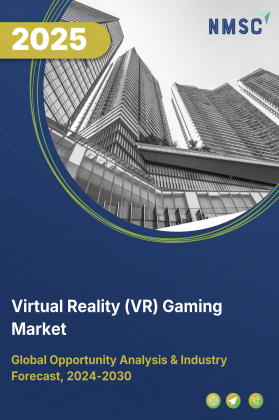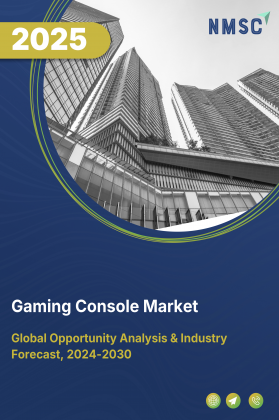
Virtual Reality (VR) Gaming Market by Component (Hardware, and Software), by User Type (Individual Consumers, and Commercial Spaces), by Technology Platform (Standalone Headsets, PC-Based Headsets, Console-Based Headsets, and Others), by Game Genre (Action & Shooter, Simulation & Sports,Adventure & RPG, and Others), by Distribution Channel (Digital Storefronts, Retail & E-commerce,Subscriptions & Bundles, and Others) – Global Opportunity Analysis and Industry Forecast – 2025–2030.
Industry Outlook
The global Virtual Reality (VR) Gaming Market size was valued at USD 38.77 billion in 2024, with an estimation of USD 50.71 billion in 2025 and is predicted to reach USD 194.17 billion by 2030 with a CAGR of 30.8% from 2025-2030. The sector is experiencing rapid growth, fuelled by the immersive experiences it delivers through interactive 3D environments, motion controllers, and headsets.
Expanding game libraries across diverse genres and increasing investments from developers and technology companies are strengthening adoption and enhancing player engagement. Strategic partnerships between hardware manufacturers and studios are further driving innovation in gameplay and performance.
However, the high cost of VR headsets and accessories continues to limit accessibility, particularly in price-sensitive markets. Looking ahead, the integration of cloud-based VR gaming presents a significant opportunity, lowering hardware barriers and broadening reach to new audiences, thereby positioning VR as a premium yet increasingly accessible segment of the gaming industry.
Immersive Experiences Driving the Growth of the Market
The virtual reality gaming market demand is growing rapidly due to the unparalleled immersive experiences it offers. Unlike traditional gaming, VR allows players to step into a fully interactive 3D environment, using motion controllers and headsets to navigate, interact, and engage with the game world.
This heightened sense of presence increases player engagement, encourages longer playtime, and drives demand for both VR hardware and software. Successful VR titles such as Half-Life: Alyx and Beat Saber demonstrate how immersive gameplay translate into strong market sales, positioning VR as a premium segment within the broader gaming industry
Expanding Game Library Encourages Market Penetration
The expansion of the VR gaming library is a key market driver. With a growing range of VR-exclusive titles spanning genres such as action, adventure, simulation, horror, and sports, the market attracts both casual and hardcore gamers.
Popular games like The Walking Dead: Saints & Sinners and Star Wars: Squadrons illustrate how unique VR content encourages adoption and boosts hardware sales. Platforms such as SteamVR and PlayStation Store continue to release new VR titles, strengthening the virtual reality gaming market penetration and sustaining consumer interest.
Increasing Investment by Game Developers Boost the Market Growth
The virtual reality gaming market expansion is witnessing strong growth, driven by substantial investments from game developers and tech companies aiming to capitalize on the rising demand for immersive experiences. Leading developers are dedicating significant resources to creating VR-exclusive titles, enhancing graphics, and integrating advanced gameplay mechanics. Partnerships between VR hardware manufacturers and game studios further optimize performance and enrich the player experience, encouraging broader adoption of VR platforms.
A recent example is Meta’s $3.5 billion investment for a 3% stake in EssilorLuxottica, the world’s largest eyewear producer and maker of Ray-Ban. This strategic move deepens Meta’s technology partnership and expands its control over hardware development in the smart glasses sector.
Meta’s growing interest in AI-powered smart glasses reflects a broader trend of tech companies investing heavily in immersive and wearable technologies, which directly supports the expansion of the virtual reality gaming market. Reports suggest that Meta increase its stake to around 5% in the future, indicating continued commitment to innovation in this space.
High Cost of Headset Restrain the Market Growth
The high price of VR headsets and compatible gaming systems remains a significant barrier to widespread adoption. Premium devices such as Meta Quest 3, PlayStation VR2, or high-end PC-tethered VR setups are considerably more expensive than traditional gaming consoles, making them less accessible to casual gamers and price-sensitive markets.
Additionally, the cost of VR accessories, such as motion controllers, sensors, and haptic devices, further increases the overall investment required. This high entry cost limits industry penetration in developing regions and slow adoption rates, despite growing interest in immersive gaming experiences. Companies must address affordability through budget-friendly models or bundled offerings to expand their consumer base and accelerate virtual reality gaming market growth.
Integration of Cloud-Based VR Gaming Creates Future Opportunity
The integration of cloud-based technologies into VR gaming is emerging as a key driver for the virtual reality gaming market growth. By allowing players to stream high-quality VR content without relying on expensive hardware, cloud-based platforms make immersive gaming more accessible to a wider audience.
Services like NVIDIA GeForce NOW, Vortex, and Shadow enable users to play VR and high-performance games on lightweight VR headsets or standard PCs, reducing entry barriers and expanding adoption in both developed and emerging markets. As cloud infrastructure and internet connectivity improve globally, this integration offers developers a scalable way to reach new gamers while enhancing the overall virtual reality gaming potential.
Market Segmentations and Scope of the Study
The virtual reality gaming market report is segmented on the basis of component, VR type, game genre, distribution channel, end user and region. On the basis of component, the market is segmented into hardware and software. On the basis of VR type, the market is categorized into PC-based, console-based, standalone, premium mobile VR, and others. On the basis of game genre, the market is classified into action, racing, shooting, fighting, mystery, puzzle, science fiction, and others. On the basis of distribution channel, the market is divided into retail, digital download, subscription, and others. On the basis of end user, the market is segmented into commercial space and individual. Regional breakdown and analysis of each of the aforesaid segments includes regions comprising North America, Europe, Asia-Pacific, and Rest of the World (RoW).
Geographical Analysis
North America continues to lead the global virtual reality gaming market share, driven by multiple factors. The region benefits from a well-established gaming infrastructure, including high-speed internet and widespread VR technology adoption. Major technology players such as Meta, Sony, and Microsoft have solidified their presence, driven innovation and expanding VR content offerings.
For example, Meta recently unveiled its next-generation virtual reality headset, the Meta Quest 3, featuring higher-resolution visuals, a lighter and thinner design, and three front-facing cameras that enhance mixed-reality experiences by allowing users to see the real world while immersed in VR. Alongside this, the growing demand for immersive gaming experiences and continuous advancements in VR hardware and software have been pivotal in propelling the market forward.
Europe’s virtual reality gaming industry is witnessing steady growth, supported by a combination of technological innovation and rising consumer interest in interactive entertainment. The region benefits from strong collaborations between gaming studios, tech companies, and academic research institutions, which drive the development of cutting-edge VR content and applications.
European gamers increasingly seek immersive and narrative-driven experiences, encouraging developers to focus on high-quality graphics, realistic gameplay, and culturally relevant storylines. Additionally, initiatives promoting digital skills, VR education programs, and gaming events across the continent are helping raise awareness and adoption of VR technologies. These factors collectively position Europe as a hub for creativity and innovation in the global industry.
The Asia-Pacific region is witnessing rapid expansion in the VR gaming market trends, driven by a combination of demographic, technological, and economic factors. A large and tech-savvy population, coupled with widespread smartphone adoption, has created a massive consumer base eager to explore immersive gaming experiences.
Countries like China, Japan, and South Korea are leading the charge, with significant investments in VR content creation, hardware development, and software innovation. The proliferation of VR arcades, gaming cafés, and dedicated VR zones has made high-quality VR experiences more accessible to the public. Additionally, the integration of VR into mobile gaming platforms, fuelled by advancements in 5G infrastructure, has enabled smoother, low-latency gameplay, even on portable devices.
The VR gaming market in the Rest of the World (RoW), encompassing Latin America, the Middle East, and Africa, is experiencing steady growth as interest in immersive gaming spreads beyond traditional sectors. In Latin America, a young and tech-savvy population, combined with increasing smartphone penetration, is driving adoption, while local developers are beginning to produce VR content tailored to regional preferences.
In the Middle East, countries such as the UAE and Saudi Arabia are investing in digital infrastructure and hosting gaming events, fostering a vibrant VR gaming culture. Africa is seeing gradual growth, with urban centers embracing VR gaming through arcades and gaming cafés, while government and private initiatives promote technology adoption. Across these regions, the combination of growing consumer interest, improving infrastructure, and strategic investments is fueling the expansion of VR gaming, setting the stage for broader market penetration in the coming years.
Strategic Innovations Adopted by Key Players
Key players in the VR gaming industry are focusing on advanced hardware launches, innovative accessory releases, and immersive content expansion to enhance player experience and drive market growth.
-
In August 2025, Meta unveiled two experimental VR headsets, Tiramisu and Boba 3, demonstrating significant advancements in virtual reality technology. Tiramisu emphasizes realism with its micro-OLED panels, boasting an extraordinary 90 pixels per degree, while Boba 3 focuses on immersive field of view with a 180-degree horizontal and 120-degree vertical FOV. Both headsets require powerful desktop GPUs and are set to be showcased at Siggraph 2025.
-
In January 2025, Shiftall introduced the GripVR and AddCon controllers, compatible with Meta Quest 3/3S/Pro, enhancing the VR gaming experience with precise tracking and interaction.
-
In September 2024, HTC launched the VIVE Focus Vision XR headset, designed for enterprises and high-end gaming. It offers standalone XR capabilities and DisplayPort mode for visually lossless PCVR, along with stereoscopic passthrough for an accurate sense of depth in mixed reality.
-
In February 2024, Apple Arcade for Apple Vision Pro introduced 12 unique spatial games and more than 250 titles, enhancing the gaming experience with stunning clarity.
-
In January 2024, Apple announced that the Vision Pro, a revolutionary spatial computer, will be available in the U.S. starting February 2, 2024, transforming how people work, collaborate, connect, relive memories, and enjoy entertainment.
Key Benefits
-
The report provides quantitative analysis and estimations of the market from 2025 to 2030, which assists in identifying the prevailing industry opportunities.
-
The study comprises a deep-dive analysis of the current and future virtual reality gaming market trends to depict prevalent investment pockets in the sector.
-
Information related to key drivers, restraints, and opportunities and their impact on the market is provided in the report.
-
Competitive analysis of the key players, along with their market share is provided in the report.
-
SWOT analysis and Porters Five Forces model is elaborated in the study.
-
Value chain analysis in the market study provides a clear picture of roles of stakeholders.
Virtual Reality (VR) Gaming Market Key Segments
By Component
-
Hardware
-
Headsets
-
Controllers
-
Tracking Sensors
-
Haptic Devices
-
Locomotion Hardware
-
Accessories & Parts
-
-
Software
-
Game Titles
-
Development Platforms
-
SDKs & Middleware
-
By User Type
-
Individual Consumers
-
Dedicated Gamer
-
Competitive Gamer
-
Social Gamer
-
Story Seeker
-
Family and Casual User
-
-
Commercial Spaces
-
VR Arcades & Lounges
-
Location-Based Entertainment
-
Theme Parks & Attractions
-
Enterprise & Education
-
Retail & Marketing
-
By Technology Platform
-
Standalone Headsets
-
PC-Based Headsets
-
Console-Based Headsets
-
Mobile-Based VR
-
Cloud-Streamed VR
-
Location-Based Systems
By Game Genre
-
Action & Shooter
-
Simulation & Sports
-
Adventure & RPG
-
Racing
-
Puzzle & Casual
-
Horror & Thriller
-
Strategy
-
Social & Multiplayer
-
Other Genres
By Distribution Channel
-
Digital Storefronts
-
Retail & E-commerce
-
Subscriptions & Bundles
-
Location-Based Tickets
-
Enterprise Licensing
-
Carrier & Platform Bundles
By Region
-
North America
-
The U.S.
-
Canada
-
Mexico
-
-
Europe
-
The UK
-
Germany
-
France
-
Italy
-
Spain
-
Denmark
-
Netherlands
-
Finland
-
Sweden
-
Norway
-
Russia
-
Rest of Europe
-
-
Asia-Pacific
-
China
-
Japan
-
India
-
South Korea
-
Australia
-
Indonesia
-
Singapore
-
Taiwan
-
Thailand
-
Rest of Asia-Pacific
-
-
RoW
-
Latin America
-
Middle East
-
Africa
-
Key Players
-
Meta Platforms, Inc.
-
Sony Interactive Entertainment LLC
-
Valve Corporation
-
HTC Corporation (HTC VIVE)
-
Apple Inc.
-
PICO Global Limited (PICO XR)
-
Rec Room Inc.
-
nDreams Limited
-
Vertigo Games B.V.
-
Resolution Games AB
-
Survios, Inc.
-
Skydance Interactive LLC
-
Cloudhead Games Inc.
-
Owlchemy Labs Inc.
-
Sandbox VR Inc.
-
Zero Latency VR Ltd.
-
Pimax Technology Co., Ltd.
-
DPVR Technology Co., Ltd.
-
SUPERHOT Team sp. z o.o.
-
Dreamscape Immersive Inc.
Report Scope and Segmentation
|
Parameters |
Details |
|
Market Size in 2025 |
USD 50.71 Billion |
|
Revenue Forecast in 2030 |
USD 194.17 Billion |
|
Growth Rate |
CAGR of 30.8% from 2025 to 2030 |
|
Analysis Period |
2024–2030 |
|
Base Year Considered |
2024 |
|
Forecast Period |
2025–2030 |
|
Market Size Estimation |
Billion (USD) |
|
Growth Factors |
|
|
Countries Covered |
28 |
|
Companies Profiled |
20 |
|
Market Share |
Available for 10 companies |
|
Customization Scope |
Free customization (equivalent up to 80 working hours of analysts) after purchase. Addition or alteration to country, regional, and segment scope. |
|
Pricing and Purchase Options |
Avail customized purchase options to meet your exact research needs. |

















 Speak to Our Analyst
Speak to Our Analyst
























